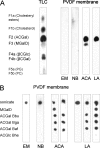Acylated cholesteryl galactosides are specific antigens of borrelia causing lyme disease and frequently induce antibodies in late stages of disease
- PMID: 19307181
- PMCID: PMC2679432
- DOI: 10.1074/jbc.M809575200
Acylated cholesteryl galactosides are specific antigens of borrelia causing lyme disease and frequently induce antibodies in late stages of disease
Abstract
Borrelia burgdorferi sensu lato is the causative agent of Lyme disease (LD), an infectious disease occurring in North America, Europe, and Asia in different clinical stages. B. burgdorferi sensu lato encompasses at least 12 species, with B. burgdorferi sensu stricto, B. garinii, and B. afzelii being of highest clinical importance. Immunologic testing for LD as well as recent vaccination strategies exclusively refer to proteinaceous antigens. However, B. burgdorferi sensu stricto exhibits glycolipid antigens, including 6-O-acylated cholesteryl beta-D-galactopyranoside (ACGal), and first the data indicated that this compound may act as an immunogen. Here we investigated whether B. garinii and B. afzelii also possess this antigen, and whether antibodies directed against these compounds are abundant among patients suffering from different stages of LD. Gas-liquid chromatography/mass spectroscopy and NMR spectroscopy showed that both B. garinii and B. afzelii exhibit ACGal in high quantities. In contrast, B. hermsii causing relapsing fever features 6-O-acylated cholesteryl beta-D-glucopyranoside (ACGlc). Sera derived from patients diagnosed for LD contained antibodies against ACGal, with 80% of patients suffering from late stage disease exhibiting this feature. Antibodies reacted with ACGal from all three B. burgdorferi species tested, but not with ACGlc from B. hermsii. These data show that ACGal is present in all clinically important B. burgdorferi species, and that specific antibodies against this compound are frequently found during LD. ACGal may thus be an interesting tool for improving diagnostics as well as for novel vaccination strategies.
Figures




Similar articles
-
Chemoenzymatic synthesis of a glycolipid library and elucidation of the antigenic epitope for construction of a vaccine against Lyme disease.Chemistry. 2010 Mar 15;16(11):3536-44. doi: 10.1002/chem.200902205. Chemistry. 2010. PMID: 20143357
-
Acylated cholesteryl galactosides are ubiquitous glycolipid antigens among Borrelia burgdorferi sensu lato.FEMS Immunol Med Microbiol. 2011 Oct;63(1):140-3. doi: 10.1111/j.1574-695X.2011.00827.x. Epub 2011 Jun 27. FEMS Immunol Med Microbiol. 2011. PMID: 21635569
-
Tick-Tattoo: DNA Vaccination Against B. burgdorferi or Ixodes scapularis Tick Proteins.Front Immunol. 2021 Feb 25;12:615011. doi: 10.3389/fimmu.2021.615011. eCollection 2021. Front Immunol. 2021. PMID: 33717102 Free PMC article.
-
Diagnosis of lyme borreliosis.Clin Microbiol Rev. 2005 Jul;18(3):484-509. doi: 10.1128/CMR.18.3.484-509.2005. Clin Microbiol Rev. 2005. PMID: 16020686 Free PMC article. Review.
-
Lyme disease and current aspects of immunization.Arthritis Res. 2002;4(1):20-9. doi: 10.1186/ar379. Epub 2001 Sep 28. Arthritis Res. 2002. PMID: 11879534 Free PMC article. Review.
Cited by
-
A Highly Expressed Human Protein, Apolipoprotein B-100, Serves as an Autoantigen in a Subgroup of Patients With Lyme Disease.J Infect Dis. 2015 Dec 1;212(11):1841-50. doi: 10.1093/infdis/jiv310. Epub 2015 May 26. J Infect Dis. 2015. PMID: 26014802 Free PMC article.
-
The major epidemiologic, microbiologic, immunologic, and clinical aspects of Lyme disease that form the basis for a newly developed vaccine that may become available soon for human use.Front Immunol. 2024 Feb 14;14:1326623. doi: 10.3389/fimmu.2023.1326623. eCollection 2023. Front Immunol. 2024. PMID: 38420513 Free PMC article. Review.
-
Hypercholesterolemia and ApoE deficiency result in severe infection with Lyme disease and relapsing-fever Borrelia.Proc Natl Acad Sci U S A. 2015 Apr 28;112(17):5491-6. doi: 10.1073/pnas.1502561112. Epub 2015 Apr 13. Proc Natl Acad Sci U S A. 2015. PMID: 25870274 Free PMC article.
-
Metabolic modeling predicts unique drug targets in Borrelia burgdorferi.mSystems. 2023 Dec 21;8(6):e0083523. doi: 10.1128/msystems.00835-23. Epub 2023 Oct 19. mSystems. 2023. PMID: 37855615 Free PMC article.
-
Identification of a novel transport system in Borrelia burgdorferi that links the inner and outer membranes.Pathog Dis. 2023 Jan 17;81:ftad014. doi: 10.1093/femspd/ftad014. Pathog Dis. 2023. PMID: 37385817 Free PMC article.
References
-
- Burgdorfer, W., Barbour, A. G., Hayes, S. F., Benach, J. L., Grunwaldt, E., and Davis, J. P. (1982) Science 216 1317–1319 - PubMed
-
- Centers for Disease Control and Prevention (2007) MMWR Morb. Mortal Wkly Rep. 56 573–576 - PubMed
-
- Dennis, D. T., and Hayes, E. B. (2002) in Lyme borreliosis: Biology, Epidemiology and Control (Stanek, G., ed) pp. 251–280, CABI publishing, Oxford, United Kingdom
-
- Fingerle, V., Schulte-Spechtel, U. C., Ruzic-Sabljic, E., Leonhard, S., Hofmann, H., Weber, K., Pfister, K., Strle, F., and Wilske, B. (2008) Int. J. Med. Microbiol. 298 279–290 - PubMed
MeSH terms
Substances
LinkOut - more resources
Full Text Sources
Other Literature Sources
Medical
Molecular Biology Databases
Research Materials

